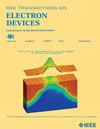利用掺银rram的准挥发性实现物理不可克隆函数的鲁棒安全原语
IF 2.9
2区 工程技术
Q2 ENGINEERING, ELECTRICAL & ELECTRONIC
引用次数: 0
摘要
基于电阻随机存取存储器(RRAM)的物理不可克隆函数(puf)由于能够生成可靠的、不可预测的映射而成为有前途的安全原语。在这项研究中,我们提出了一种新的PUF架构,该架构利用了由掺银RRAM器件组成的$32 × 32$交叉棒阵列的时间和空间随机性的准波动性。该PUF基于RRAM器件的固有开关可变性和时间保持特性构建了唯一标识符。这种随机性的双重来源确保了高不可预测性和对环境噪声和常见建模攻击的鲁棒性。在优化实验中,PUF的均匀性、间hamming距离(inter-HD)和内hamming距离(intra-HD)指标分别达到49.9%、50.11%和0%,表现出较强的稳定性和抗误码能力。该体系结构采用临时多数投票(TMV)方案来纠正比特错误,而无需额外的硬件,实现误码率(BER)为0%。这些结果突出了这种基于ram的PUF在安全密钥和身份生成应用中的潜力,特别是在要求苛刻的物联网(IoT)和嵌入式系统中。未来的工作将集中在进一步评估针对高级攻击的弹性,并将PUF集成到完整的安全系统中。本文章由计算机程序翻译,如有差异,请以英文原文为准。
Exploiting Quasi-Volatility in Silver-Doped RRAMs for Physical Unclonable Functions Toward Robust Security Primitives
Resistance random access memory (RRAM)-based physical unclonable functions (PUFs) have emerged as promising security primitives owing to their ability to generate reliable, unpredictable maps. In this study, we propose a novel PUF architecture that leverages the quasi-volatility of temporal and spatial randomness in a $32\times 32$ crossbar array composed of silver-doped RRAM devices. The proposed PUF constructs a unique identifier based on the intrinsic switching variability and temporal retention characteristics of the RRAM devices. This dual source of randomness ensures high unpredictability and robustness against environmental noise and common modeling attacks. In optimized experiments, the PUF achieved uniformity, inter-hamming distance (inter-HD), and intra-hamming distance (intra-HD) metrics of 49.9%, 50.11%, and 0%, respectively, demonstrating strong stability and resistance to bit errors. The architecture incorporates a temporal majority voting (TMV) scheme to correct bit errors without additional hardware, achieving a bit error rate (BER) of 0%. These results highlight the potential of this RRAM-based PUF for secure key and identification-generation applications, especially in demanding internet of things (IoT) and embedded systems. Future work will focus on further evaluating the resilience against advanced attacks and integrating the PUF into complete security systems.
求助全文
通过发布文献求助,成功后即可免费获取论文全文。
去求助
来源期刊

IEEE Transactions on Electron Devices
工程技术-工程:电子与电气
CiteScore
5.80
自引率
16.10%
发文量
937
审稿时长
3.8 months
期刊介绍:
IEEE Transactions on Electron Devices publishes original and significant contributions relating to the theory, modeling, design, performance and reliability of electron and ion integrated circuit devices and interconnects, involving insulators, metals, organic materials, micro-plasmas, semiconductors, quantum-effect structures, vacuum devices, and emerging materials with applications in bioelectronics, biomedical electronics, computation, communications, displays, microelectromechanics, imaging, micro-actuators, nanoelectronics, optoelectronics, photovoltaics, power ICs and micro-sensors. Tutorial and review papers on these subjects are also published and occasional special issues appear to present a collection of papers which treat particular areas in more depth and breadth.
 求助内容:
求助内容: 应助结果提醒方式:
应助结果提醒方式:


